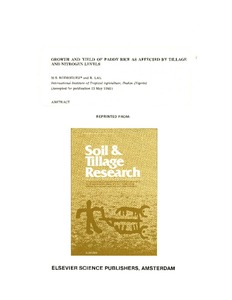| dc.contributor.author | Rodríguez, M.S. |
| dc.contributor.author | Lal, R. |
| dc.date.accessioned | 2019-12-04T11:08:39Z |
| dc.date.available | 2019-12-04T11:08:39Z |
| dc.date.issued | 1985 |
| dc.identifier.citation | Rodriguez, M.S. & Lal, R. (1985). Growth and yield of paddy rice as affected by tillage and nitrogen levels. Soil and Tillage Research, 6(2), 163-178. |
| dc.identifier.issn | 0167-1987 |
| dc.identifier.uri | https://hdl.handle.net/20.500.12478/1881 |
| dc.description.abstract | Although tropical wetlands are rapidly being developed for the needed increase in rice (Oryza sativa L.) production, knowledge is still limited concerning the optimum soil and crop management practices. A study was thus carried out to evaluate the effects of different tillage systems on the growth and yield of paddy rice, grain yield response to N applications, and weed control. Five experiments were conducted for three consecutive seasons on hydromorphic soils (loamy and sandy loamy, mixed, isohyperthermic Aeric Tropaqualfs) at the International Institute of Tropical Agriculture, Ibadan, comparing the effects of zero tillage (without dry tillage and puddling) and conventional tillage (dry tillage and puddling) at two or more N levels. In two of the above experiments the effects of either two moisture regimens or chemical versus manual weed control were also evaluated.
In four experiments there were no statistically significant differences in grain yield between zero-tillage plots sprayed with paraquat and conventional-tillage plots. Only in Experiment 2 did zero-tillage (with paraquat) plots give a significantly lower yield than conventional-tillage plots (5200 versus 5580 kg ha−1, respectively) but the difference could be explained by greater rat damage in the former. The highly significant response in grain yield to N applications in all five experiments was statistically similar under both tillage systems. The continuous flooding treatment (Experiment 1) gave better weed control and higher grain yield than the saturation moisture regime (6150 versus 5420 kg ha−1 grain yield). In zero-tillage plots where weeds were slashed before transplanting (Experiment 2), grain yield was lower and the weed growth greater than in zero-tillage and low N level. Satisfactory weed control was obtained with paraquat and continuous flooding. |
| dc.format.extent | 163-178 |
| dc.language.iso | en |
| dc.subject | Rice |
| dc.subject | Ammonium Sulphate |
| dc.subject | Tillage |
| dc.subject | Paddy Rice |
| dc.subject | Land Preparation |
| dc.subject | Weed Control |
| dc.title | Growth and yield of paddy rice as affected by tillage and nitrogen levels |
| dc.type | Journal Article |
| dc.description.version | Peer Review |
| cg.contributor.affiliation | International Institute of Tropical Agriculture |
| cg.coverage.region | Africa |
| cg.coverage.region | West Africa |
| cg.coverage.country | Nigeria |
| cg.isijournal | ISI Journal |
| cg.authorship.types | CGIAR single centre |
| cg.iitasubject | Land Use |
| cg.iitasubject | Weeds |
| cg.journal | Soil & Tillage Research |
| cg.howpublished | Formally Published |
| cg.accessibilitystatus | Limited Access |
| local.dspaceid | 83739 |
| cg.targetaudience | Scientists |
| cg.identifier.doi | https://doi.org/10.1016/0167-1987(85)90014-5 |

